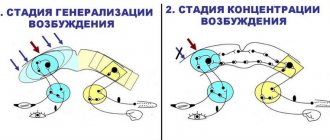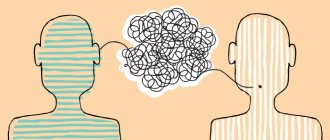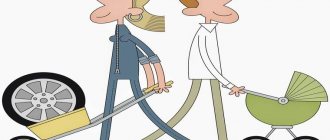Higher nervous activity is a system that allows the human and animal body to adapt to variable environmental conditions. Evolutionarily, vertebrates have developed a number of innate reflexes, but their existence is not enough for successful development.
In the process of individual development, new adaptive reactions are formed - these are conditioned reflexes. Outstanding domestic scientist I.P. Pavlov is the founder of the doctrine of unconditioned and conditioned reflexes. He formed the conditioned reflex theory, which states that the acquisition of a conditioned reflex is possible through the action of a physiologically indifferent irritation on the body. As a result, a more complex system of reflex activity is formed.
I.P. Pavlov - the founder of the doctrine of unconditioned and conditioned reflexes
An example of this is Pavlov's study of dogs that salivated in response to a sound stimulus. Pavlov also showed that innate reflexes are formed at the level of subcortical structures, and new connections are formed in the cerebral cortex throughout the life of an individual under the influence of constant irritations.
What is a conditioned reflex?
A conditioned reflex is an acquired reflex, characteristic of an individual, and not genetically fixed (i.e., not inherited). The formation of such reflexes depends on the conditions of their occurrence, which was the reason for the appearance of the name of the group. The foundation for their appearance is the presence of a connection between the emerging stimulus and the unconditioned reflex act, which serves as reinforcement for it. In this case, the connection has a certain time frame. The brain, both its cortex and the formations located under it, are responsible for the generation and manifestation of reflexes.
One of the first scientists to seriously study this topic and propose the definition of “conditioned reflex” in 1903 was the Russian physiologist I.P. Pavlov.
Biologically, the reflex is intended to transform external stimuli of a neutral nature into a set of significant signals that adapt the behavioral characteristics of the organism to current conditions. In fact , they ensure the body’s adaptation to emerging phenomena in order to generate useful behavior and eliminate negative effects on the body. Conditioned reflexes provide adaptation to both natural influences and the actions of the individual’s social environment.
Research by I.M. Sechenov
Ivan Mikhailovich Sechenov (1929–1905) – physiologist, naturalist, physician, a person who made a significant contribution to the development of psychology. Sechenov presented a program for the construction of psychology simultaneously with V. Wundt. He can be considered the founder of Russian scientific psychology.
The initial natural scientific premise is the reflex theory of I.M. Sechenov has a position on the unity of the organism and the environment, on the active interaction of the organism with the outside world. This position constituted the first general biological prerequisite for Sechenov’s discovery of brain reflexes . Conditioned by external influences, the reflex activity of the brain is the “mechanism” through which an organism that has a nervous system communicates with the outside world.
The brain reflex is, according to Sechenov, a learned reflex, that is, not innate, but acquired during individual development and depending on the conditions in which it is formed.
The second physiological prerequisite for the reflex theory was Sechenov’s discovery of central inhibition. It was the first step towards the discovery of the internal patterns of brain activity.
Central inhibition is a special mechanism in the brain that suppresses or suppresses reflexes, that is, the body’s response to external influences. The effect of reflex inhibition was discovered in numerous experiments on frogs. Subsequent experiments showed that the effect of central inhibition is important for any animal: it protects the nerve cells of the cerebral cortex and protects the nervous system from overexcitation.
Theory I.M. Sechenov was built on the concept of “reflex”. He believed that the ability to perceive external influences in the form of ideas (visual, auditory, etc.), as well as the ability to analyze these specific impressions, memory and all mental acts, develops through reflex.
Thus, the scheme of the mental process is the same and repeats the scheme of the reflex: the mental process originates in an external influence, continues in the central nervous system and ends with a response - movement, action, speech.
THEM. Sechenov always emphasized the real life significance of the psyche. Analyzing the reflex act, he characterized its first part, beginning with the perception of sensory excitement, as a signal one. At the same time, sensory signals “pre-notify” about what is happening in the environment.
In accordance with the signals entering the central nervous system, the second part of the reflex act carries out movement. Sechenov emphasized the role of “feeling” in the regulation of movement. The working organ (muscle) that carries out the movement participates in the emergence of the mental as not an effector, but a receptor that gives sensory signals about the movement performed. These same sensory signals form “touches” with the onset of the next reflex.
At the same time, Sechenov clearly shows that mental activity can regulate actions, designing them in accordance with the conditions in which they are performed, only because it carries out the analysis and synthesis of these conditions.
Thus, according to Sechenov, brain reflexes begin with sensory stimulation, continue with a certain mental act and end with muscle movement, since the middle link cannot be separated from the first and third, and also since all mental phenomena are an inseparable part of the entire reflex process, which has the reason lies in the influences of the real world external to the brain.
In other words, the reflex begins with distinguishing (thanks to the sensory organs) those external conditions in which the response action is performed. Here we see in reality the idea of an inseparable connection between the organism and the environment. This movement is not a simple reflection, like the way a ray is reflected from a mirror surface. It occurs only because it is consistent with the conditions of the external environment thanks to signals coming from it to the organs of perception and discrimination of these signals. But the matter is not limited to this.
A muscle, according to Sechenov, is not only a working machine that carries out commands from the brain. The muscle also serves as an organ of cognition. It contains nerve (sensory, sensitive) endings that signal the external spatiotemporal conditions in which the action is performed. Moreover, further research led Sechenov to the hypothesis that it is the working muscle that performs the operations of analysis, synthesis, comparison of objects and is capable of producing unconscious conclusions (in other words, thinking).
It follows from this that only apparently reflex work ends with muscle contraction. The cognitive effects of its work are transmitted “back” to the centers of the brain and on this basis the picture (image) of the perceived environment changes. Therefore, in the mechanism of behavior implemented by the reflex type, in contrast to the reflex arc, a reflex ring operates. Ring control of the organism's behavior in the environment occurs continuously. It forms the foundation on which another, higher level of relationship between the organism and the environment is formed.
The latter differs in that behavior becomes mentally regulated. If earlier the main principle was, as it was said, “coordination of movement with feeling - a signal,” now a new level of orientation of the organism in the surrounding world arises. There is a transition from the behavioral level to the mental level. Mental processes arise on the basis of reflexively organized behavior.
Examples of conditioned reflexes
The most striking example of a conditioned reflex is the secretion of saliva in pets at the sound of a food bowl. Similar processes can be developed in humans. The condition for their occurrence is the high repeatability of situations with the coincidence of two processes, for example, hitting a bowl and placing food in it.
Similarly, in animals, the reaction to a bell will be to flex the paw if the procedure in which the operation of the bell coincided with the effect of an electric current on the animal, stimulating the flexion reflex of the paw, has been previously repeated many times.
For a child, a conditioned reflex in the form of withdrawing his hands from fire is common, but it will develop only if the child has previously received a burn, and the body is protected from the recurrence of negative effects on it.
What reflexes are unconditioned?
An unconditioned reflex is the main form of activity of the nervous system, an automatic reaction to a stimulus. And since a person is influenced by various factors, the reflexes are different: food, defensive, orientation, sexual... Food include salivation, swallowing and sucking. Defensive actions include coughing, blinking, sneezing, and jerking limbs away from hot objects. Approximate reactions include turning the head and squinting the eyes. Sexual instincts include those associated with reproduction, as well as caring for offspring. The significance of the unconditioned reflex is that it ensures the preservation of the integrity of the body and maintains the constancy of the internal environment. Thanks to him, reproduction occurs. Even in newborn children, one can observe an elementary unconditioned reflex - sucking. By the way, it is the most important. The irritant in this case is touching the lips of any object (pacifier, mother's breast, toy or finger). Another important unconditioned reflex is blinking, which occurs when a foreign body approaches the eye or touches the cornea. This reaction belongs to the protective or defensive group. Children also experience constriction of the pupils, for example, when exposed to strong light. However, the signs of unconditioned reflexes are most clearly manifested in various animals.
Distinctive features of conditioned reflexes
- Absent in newborns. The unconditioned reflex is inherent in nature, while the conditioned reflex is acquired and individual.
- The development of such reflexes is the prerogative of the higher department of the central nervous system.
- They can be temporary in cases where the stimulus does not have unconditional reinforcement.
- Conditioned reflexes are not fixed genetically, i.e. are not inherited;
All conditioned reflexes are divided into two component categories: natural and artificial. The first include the natural properties of the stimulus, for example, the type of fire. The second includes reflexes to stimuli that do not have a direct connection with the action, for example, the operation of a light bulb for Pavlov’s dog.
Definition
Instincts are natural impulses that generally control human behavior. Instincts are inherited by people from their ancestors and manifest themselves regardless of environmental conditions and upbringing. Their value is invaluable. For example, thanks to the action of the instincts of self-preservation and procreation, life on Earth does not cease to exist.
Reflexes are automatic reactions of the body to stimulating factors. There are reflexes that a person possesses from birth, called unconditioned. So, a newborn, finding himself in a position on his stomach, reflexively turns his head to the side, which allows him to breathe freely. In parallel with the development and acquisition of experience, a person “acquires” conditioned reflexes. For example, a small child, not knowing that nettle stings, can calmly touch it with his hands. But, having experienced unpleasant sensations, the next time he will withdraw his hand without even touching the plant.
Principles of generating conditioned reflexes
The foundation of acquired skills is conditioned reflex mechanisms. They, in turn, ensure the emergence of connections between the associative neurons of the cerebral cortex and the nuclei located under it in the cerebral hemispheres.
The emergence of conditioned reflexes is based on the transformation of insignificant signals into significant ones through repeated repetition in the presence of an important unconditional stimulus, for example, the provision of food or physical influence. As a result, conditioned reflexes act as one of the criteria for assessing an organism, human or animal.
Physiologically, the process of the emergence of a conditioned reflex, using the example of Pavlov’s experiments, involves the passage of the following stages:
- The emergence of a focus of excitation in the cerebral cortex as a result of exposure to a conditioned stimulus, for example, turning on a light bulb.
- The emergence of a focus of excitation caused by an unconditioned stimulus, for example, the provision of food.
- With a certain periodicity and frequency of occurrence of the stimulus, a temporary relationship is formed between two foci of excitation.
- Subsequently, the appearance of a conditioned stimulus (light bulb) leads to the emergence of reflexes initially experienced by the provision of unconditioned stimuli (food)
Higher nervous activity
Higher nervous activity (HNA), carried out by the cerebral cortex, ensures the most perfect adaptation of humans and animals to constantly changing environmental conditions and underlies higher mental functions of humans, such as thinking, memory, consciousness and learning.
“Father of Russian physiology” - I.M. Sechenov wrote the book “Reflexes of the Brain,” where he put forward a theory about the reflex principle that underlies the activity of the internal nervous system. These ideas were continued and developed by I.P. Pavlov, who experimentally proved that conditioned reflexes underlie GNI.
While studying the digestive system, you learned about the experience of I.P. Pavlov, with the help of which he studied the mechanism of salivation. After conducting experiments, Pavlov discovered that some of the reflexes are innate - permanent, and the other - acquired.
With numerous coincidences of the conditioned (signal) and the unconditioned stimulus reinforced by it, a conditioned reflex is formed. That is, a conditioned reflex always arises on the basis of an unconditioned reflex with repeated coincidence of the above stimuli.
Conditioned and unconditioned reflexes
Now let’s look in more detail at the differences between conditioned reflexes and unconditioned ones:
- Acquired - congenital
- Individual - group
- Nonspecific - specific
- Changeable - constant
- With bark - without bark
Conditioned reflexes are acquired: they are absent in a newborn and can arise and fade throughout life. Unconditioned reflexes are innate, genetically determined and inherited.
Conditioned reflexes are individual, determined by previous experience: a child who sees a lemon for the first time in his life does not salivate, but after eating it, even the thought of a lemon can cause profuse salivation. Unconditioned reflexes are characteristic of all individuals of the species without exception.
Conditioned reflexes arise in response to a nonspecific stimulus, for example, light, if the dog has a conditioned reflex to light. Unconditioned reflexes arise in response to a specific stimulus: sound is perceived by the receptors of the inner ear, light - by the rods and cones of the retina.
Conditioned reflexes are acquired as an adaptation to specific environmental conditions; when the environment changes, they also change and can be lost and reappear. Unconditioned reflexes are constant, given from birth and do not fade throughout life.
Conditioned reflexes always arise and are carried out with the participation of the cerebral cortex; unconditioned reflexes can do without its participation. The main thing is to remember and realize that any conditioned reflex is carried out on the basis of an unconditioned reflex.
The mechanism of conditioned reflex formation
The study of conditioned reflexes is closely connected with Pavlov and his students. Now we will conduct an experiment on a dog.
Let's assume that we need to develop a salivation reflex in an animal in response to turning on the light. We will use food as an unconditional stimulus, and turning on a light bulb as a conditioned stimulus.
A few seconds before we give food to the dog, we need to turn on the light bulb. If we repeat this manipulation several times, the dog will develop a conditioned reflex to turn on the light bulb, and in the future, salivation will begin at the moment the light turns on.
This effect is due to the fact that in the dog’s brain a temporary connection arises between the visual center (in the occipital lobe of the CBP) and the food center. As our manipulation is repeated, this temporary connection becomes stronger - a closure occurs and a conditioned reflex is formed.
Inhibition of reflexes
Inhibition processes are obligatory concomitants of excitation processes in the nervous system. Sechenov was the first to discover and describe the process of inhibition, proving that irritation of the nerve centers of the diencephalon inhibits the reflex activity of the spinal cord.
Pavlov developed the teachings of Sechenov and also studied the processes of inhibition. He came to the conclusion that in the nervous system the processes of excitation and inhibition are interconnected and occur continuously. Moreover, thanks to inhibition, the conditioned reflex is of the most accurate and perfect adaptive nature in relation to the environment.
Pavlov described two types of cortical inhibition:
- Unconditional (external)
- Conditional (internal)
Unconditional (external) inhibition is associated with the emergence in the cerebral cortex of a new (external) focus of excitation caused by the action of some external stimulus (sharp sound, loud noise). The action of this stimulus causes a weakening or complete disappearance of the current conditioned reflex.
This is an innate inhibition; it does not require development, which is why Pavlov called it unconditional (external).
Conditioned (internal) inhibition occurs in the same area of the cortex where the center of the conditioned reflex is located. Conditioned inhibition develops gradually. Remember how we developed a conditioned reflex in a dog to turn on a light bulb. If we stop giving food and continue to turn on the light bulb, then gradually the dog’s salivation will fade away - this is conditioned inhibition.
In order for the conditioned reflex to be maintained, it is necessary to reinforce it as often as possible: in our case, light (the conditioned stimulus) is reinforced with food (the unconditioned stimulus). If you stop turning on the light bulb before giving the dog food, the conditioned reflex will gradually weaken and disappear. This process is called extinction - the disappearance of a conditioned reflex, but if desired, it can be created again.
Pavlov's doctrine of the first and second signal systems
Animals have only the first signaling system. Pavlov considered it as a set of nervous structures with the help of which the perception of the surrounding world occurs through the senses. The signals in the first signaling system are smell, color, sound - they cause unconditioned reflexes and serve as the basis for the formation of conditioned reflexes.
Pavlov also proved that animals do not have a second signaling system. His experiment consisted of placing a monkey on a raft in the middle of a lake. The monkey could use a pole to climb onto two other rafts. On one of them there was a bailer and a tank of water, on the other raft a fire started. The monkey put out the fire by performing complex actions: each time he climbed onto a raft with a water tank and scooped water from there, instead of scooping water from a lake, which was much closer. Consequently, animals are not capable of generalization and abstract thinking.
In the process of work and communication, a person developed a second signaling system, closely related to the emergence of speech. Here, the specific irritant is the words into which a person puts meaning, some concept.
Words have a generalizing meaning, which served as the basis for the possibility of generalization, abstraction and operating with concepts. Language puts the results of human activity into words, so you can imagine a monkey even if you don't see it. Thanks to oral and especially written speech, it becomes possible to transfer experience to future generations. For any book, including this textbook, it is also worth saying special thanks to the second signaling system.
Temperament types
Pavlov identified four types of temperament, depending on the strength, balance and mobility of nervous processes in the cerebral cortex. Choleric is an easily excitable type, sanguine is balanced. Phlegmatic - processes of excitation and inhibition of weak strength, persistent and diligent in work. And finally, a melancholic person - the processes of excitation and inhibition are unbalanced and weak - are very vulnerable and weak-willed, prone to deep experiences.
Emotions, thinking and memory
Emotions are a person’s subjective reactions to external and internal stimuli. Emotions can be positive and negative; they reflect subjective experiences about the objective surrounding reality.
Thinking is a set of mental processes aimed at understanding the surrounding reality and thanks to which a person understands the essence of phenomena and things - as a result of thinking, concepts are formed. A distinction is made between elementary thinking, which is inherent in all animals (the first signaling system), and abstract thinking, which is characteristic only of humans (the second signaling system).
Memory is the ability of the nervous system (brain), which consists in the possibility of consolidating, storing and further reproducing received information. Based on the storage time of information, memory is divided into short-term and long-term.
Any information we receive first goes into short-term memory, only with repeated reproduction does this information move into long-term memory. The following types of memory are distinguished: visual, auditory, motor, tactile, mixed.
Dream
Sleep is a state of depression of consciousness, during which all types of sensitivity are reduced. Normally, the duration of sleep in an adult is 7-8 hours; in newborns, the duration of sleep reaches 18-20 hours a day. During sleep, information received during the day is transferred to long-term memory. Without sleep for more than 1-2 weeks, death is possible.
There are two phases of sleep: slow and fast, which alternate several times in one night. The slow-wave sleep phase consists of physiological rest of all body systems: heart rate, blood pressure, and body temperature decrease. Hormones begin to be released more actively, the action of which is associated with tissue restoration.
The REM sleep phase is the phase in which we dream. In this interval, the eyeballs actively move, breathing may become more frequent, and the hands make movements. This phase occurs approximately every 60-80 minutes (after the slow-wave sleep phase). Thus, in one night we see many dreams, most of which we forget. By the way, various “smart” alarm clocks catch exactly the moment of the REM sleep phase, in which it is easiest to wake a person, and upon awakening, the dream is usually remembered.
A dream is a unique representation of received information in the form of visual images. Let me note an interesting fact: we have already seen all the people we see in our dreams in reality. It could have been the face of a random passerby we met several years ago: such information is hidden deep in the subconscious.
Many of us, including me, have experienced a state of altered consciousness - a lucid dream. This is surprising, but sometimes during sleep a person can realize that he is dreaming, his dream is unreal, and it can be changed as soon as he pleases. After such moments, you experience extreme euphoria, dreams with your own scenario are remembered for a long time.
Diseases
Somnambulism (obsolete - sleepwalking) is a painful condition in which people perform any actions while in a state of sleep. Most often, sleepwalking occurs during a period of incomplete awakening after a deep sleep phase. An attack of sleepwalking can last up to several hours; sleepwalking most often occurs in children.
This condition has been known since ancient times, but its causes still remain a mystery. There is also no information whether sudden awakening harms a sleepwalker in a state of sleepwalking or not. Most often, sleepwalkers perform stereotypical actions: getting up, cleaning, walking, after which they go to bed and the next morning they do not remember anything about what happened.
Sometimes the actions of sleepwalkers pose a danger to themselves and others. There are cases when sleepwalkers traveled hundreds (!) kilometers from their home, and after waking up they found themselves in another part of the country completely disoriented.
© Bellevich Yuri Sergeevich 2018-2021
This article was written by Yuri Sergeevich Bellevich and is his intellectual property. Copying, distribution (including by copying to other sites and resources on the Internet) or any other use of information and objects without the prior consent of the copyright holder is punishable by law. To obtain article materials and permission to use them, please contact Yuri Bellevich
.
The main criteria for the appearance of a conditioned reflex
The development of a conditioned reflex requires the presence of certain conditions:
- The conditioned stimulus must have a certain strength.
- The appearance of a conditioned stimulus should predict the appearance of an unconditioned stimulus.
- The unconditioned stimulus must be more powerful.
- No other irritants.
- Absence of pathologies in the body of the subject under study.
If the specified conditions are met, the formation of almost any conditioned stimulus is possible.
Species specificity
Unconditioned reflexes (specific) are present in both humans and animals. It should be understood that such reactions will be the same in all representatives of the same species. An example is a turtle. All species of these amphibians retract their heads and limbs into their shell when danger arises. And all the hedgehogs jump and make a hissing sound. In addition, you should know that not all unconditioned reflexes occur at the same time. These reactions vary with age and season. For example, the breeding season or the motor and sucking actions that appear in an 18-week fetus. Thus, unconditioned reactions are a kind of development for conditioned reflexes in humans and animals. For example, as cubs grow older, they transition to the category of synthetic complexes. They increase the body's adaptability to external environmental conditions.
Classification of conditioned reflexes
There are a large number of conditioned reflexes, so a classification system has been developed for them based on various criteria.
- Based on unconditioned reflexes , they are divided into: food, sexual, protective, and so on.
- Depending on the receptors involved, it is customary to divide conditioned reflexes into exteroceptive, interoceptive and proprioceptive.
- According to the structure of the conditioned stimulus, reflexes are simple and complex. Moreover, in fact, most stimuli are complex in nature, combining various, interrelated stimuli.
- Conditioned reflexes can be of one of three orders. The first category includes stimuli that have additional unconditional reinforcement. The second order includes stimuli that are reinforced by a conditioned stimulus that has previously ensured the appearance of a conditioned reflex. The duration of the reflex chains is determined by the capabilities of the nervous system of a living creature. If in fish it consists of no more than two elements, then for primates the chains can be formed in twenty orders.
- Depending on the source of origin of the stimulus, reflexes occur natural and artificial. In the first case, the stimuli are of natural, natural origin. Compared to the background of artificial stimuli, they are simpler and more understandable for the subject being studied.
Inhibition of conditioned reflexes
For the adequacy of the behavior of the organism and its maximum adaptation to external influences, only the appearance of conditioned reflexes is not enough. A response action is required that has the opposite direction to the emerging stimulus. This process is called inhibition, and is designed to cut off emerging reactions for which there is actually no need. Research conducted by I.P. Pavlov led the author to identify several variants of cortical inhibition. Unconditioned inhibition is a response to various external stimuli. Conditioned inhibition is determined by internal processes.
With unconditional inhibition, a new focus of excitation appears, the generation of which is associated with an external stimulus, for example, the appearance of a sharp and loud noise. When exposed to it, the conditioned reflex becomes significantly weaker or disappears completely.
Conditioned inhibition at the place of origin fully corresponds to the point at which the center of the conditioned reflex is located. The development of this type of inhibition requires consistency. This can be seen in the example of Pavlov's dog. If at first, when you turn on the light bulb without providing food, stable salivation is observed, then over time it will gradually fade away, that is, conditioned inhibition appears.
Unconditioned instinct and reflex of animals
The exceptional constancy of the nervous connection underlying unconditional instinct is explained by the fact that all animals are born with a nervous system. She is already able to respond appropriately to specific environmental stimuli. For example, a creature may flinch at a sharp sound; he will secrete digestive juice and saliva when food enters his mouth or stomach; it will blink when visually stimulated, and so on. Innate in animals and humans are not only individual unconditioned reflexes, but also much more complex forms of reactions. They are called instincts.
An unconditioned reflex, in fact, is not a completely monotonous, template, transfer reaction of an animal to an external stimulus. It is characterized, although elementary, primitive, but still by variability, variability, depending on external conditions (strength, peculiarities of the situation, position of the stimulus). In addition, it is influenced by the internal states of the animal (decreased or increased activity, posture, etc.). So, also I.M. Sechenov, in his experiments with decapitated (spinal) frogs, showed that when the toes of the hind legs of this amphibian are exposed, the opposite motor reaction occurs. From this we can conclude that the unconditioned reflex still has adaptive variability, but within insignificant limits. As a result, we find that the balancing of the organism and the external environment achieved with the help of these reactions can be relatively perfect only in relation to slightly changing factors of the surrounding world. The unconditioned reflex is not able to ensure the animal’s adaptation to new or sharply changing conditions.
As for instincts, sometimes they are expressed in the form of simple actions. For example, the rider, thanks to his sense of smell, finds the larvae of another insect under the bark. It pierces the bark and lays its egg in the found victim. This ends all of its actions that ensure continuation of the family. There are also complex unconditioned reflexes. Instincts of this kind consist of a chain of actions, the totality of which ensures procreation. Examples include birds, ants, bees and other animals.









